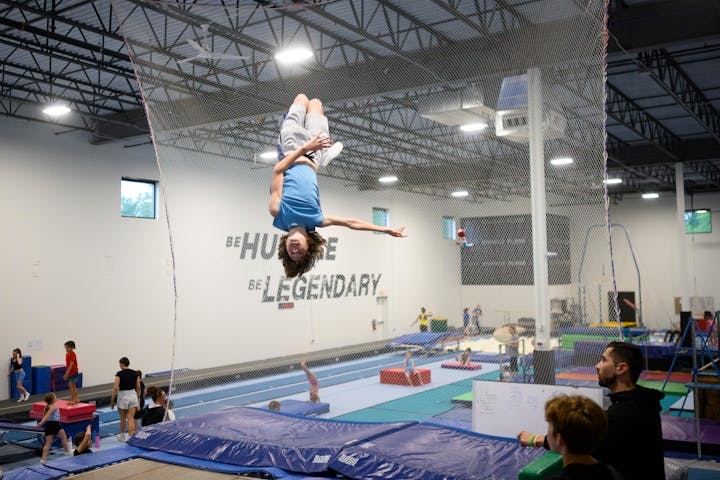One of the most visually arresting, what-in-the-world-is-happening athletic competitions is coming to the Minneapolis Convention Center as USA Gymnastics takes over downtown beginning June 21.
Trampoline gymnastics, which was added to the Olympics in 2000, is a hyperspecialized event that combines childhood abandon with rigorous discipline and the inherent danger that comes with sending your body soaring before attempting a springy, interlinked 10-skill routine of somersaults and twists.
The United States will send one man and one woman to represent the country in trampoline gymnastics at the Paris Games. The representatives, along with two alternates, will be announced June 26 in Minneapolis. Here’s what to look for as the gymnasts take to the air.
The trampoline
The dimensions of the trampoline are uniform for Olympic competition — 16 feet, 6 inches in length; 9 feet, 5 inches in width, and 3 feet, 9 inches in height. Red demarcation lines run along the long edge of the trampoline to show the exercise zone for the gymnast.
Landing outside of that zone impacts scoring, and the goal is to stay as close to the red plus sign at the center as possible.
But while gymnasts can prepare for the parameters, they cannot prepare for the unique relationship they’ll have with a specific trampoline until they step onto it.
“We train on all different trampolines so we never get comfortable,” said Nicole Ahsinger, who represented the U.S. and finished sixth in women’s trampoline at the Tokyo Games in 2021. “We’re always a little uncomfortable so when you go to a competition and you’re on this brand-new trampoline, no matter if it feels bouncy or tight or it pulls a little bit to the right or the left, no matter what it is, we will always feel comfortable in knowing we will be able to hit a routine.”
Some skills are meant to move the body from side to side or utilize an unusual angle to showcase a particular movement. But often, the gymnast is responding to the tensile nylon of the trampoline bed in real time, and their ability to adjust and stay calm is built through years of working with different trampolines.
“You are in a relationship with that trampoline,” said Nick George, a former member of the U.S. national team who coaches trampoline at Twin City Twisters in Champlin. “Both how it treats you and how you treat it.”
The routine iframe.mobile { display:none; } div.wideview{ width:1000px; margin-left:-225px; margin-bottom:150px; } @media only screen and (max-width:768px) { iframe.mobile { display:block; } div.wideview { display:none; } }
George said there are unifying elements to a winning routine: “If you want to be good, you gotta be pretty. Straight lines. Straight arms.”
Ahsinger’s routines are illustrative. There are moments when her body becomes utterly uniform — like a satellite moving through outer space.
“When you see that, as a spectator, that the athlete almost looks like they’re not moving in their movement, they have done a killer skill,” Ahsinger said. “They have showcased that skill the best they can do.”
.gymn-video{ padding-top:50px; margin-bottom:75px; }
A gymnast’s goal is to keep their body centered around the middle of the trampoline and make smooth transitions, so the ability to keep your mind still when you get slightly off-center is just as vital to a strong routine, George said.
“We always teach learning to lift your body up in the air, reach nice and tall, and those drills help the athlete understand, if I do get nervous, what can I do on the trampoline in the moment to save my routine?”
The national championships will start June 24 with a qualifying round in which each gymnast attempts two routines — one that is compulsory with eight set skills and two unique skills for all competitors, and one that is voluntary with all 10 skills determined individually. The top eight male and top eight female gymnasts will advance to the final round on June 26, where there is one voluntary routine.
The scoring
Each routine is judged on three values — time of flight, difficulty and execution — and a panel of nine judges determines the final score.
Time of flight has become objective with the introduction of the “time of flight” machine, which debuted in 2011 ahead of the London Games. It tracks the total flight time for each gymnast.
The difficulty score is based on the skills a gymnast plans to attempt during their routine, and each skill has a predetermined score. Once the judges verify that the gymnast has executed the routine they intended, that provides an overall difficulty score.
Execution scoring is more subjective and requires five judges. They judge the skill and form of each routine — the “pretty” element that George mentioned — for aesthetic and physical beauty. They look to see if arms and legs are straight and if the gymnast is landing near the middle of the trampoline, and they determine deductions when things go awry.
The five judges’ scores are tallied, the highest and lowest scores are dropped, the remaining three scores are added together and you get a final execution score.
Combine the scores for time of flight, difficulty and execution, and you get a final score in qualifying that determines who advances to the finals for another round of scoring.
How are the Olympians and alternates selected? The championships in Minneapolis are the third and final competition where trampoline gymnasts can record a qualifying score to try to reach Paris. The previous two events were the 2024 Winter Classic and Elite Challenge. The man and woman with the highest combined scores will make the U.S. Olympic team. The athletes with the next two highest scores will be the alternates.
Illustration by Yuqing Liu and Mark Boswell.


